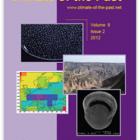Engler, Steven, Franz Mauelshagen, Jürg Luterbacher, and Johannes Werner. “The Irish Famine of 1740–1741: Famine Vulnerability and ‘Climate Migration.’” Climate of the Past 9, no. 3 (2013): 1161–1179.
The “Great Frost” of 1740 was one of the coldest winters of the eighteenth century and impacted many countries all over Europe. The years 1740–1741 have long been known as a period of general crisis caused by harvest failures, high prices for staple foods, and excess mortality. Vulnerabilities, coping capacities, and adaptation processes varied considerably among different countries. This paper investigates the famine of 1740-1741 in Ireland applying a multi-indicator model developed specifically for the integration of an analysis of pre-famine vulnerability, the Famine Vulnerability Analysis Model (FVAM). Our focus is on Ireland, because famine has played a more outstanding role in Irish national history than in any other European country, due to the “Great Famine” of 1845–1852 and its long-term demographic effects. Our analysis shows that Ireland was already particularly vulnerable to famine in the first half of the eighteenth century. During and after the experience of hardship in 1740–1741, many Irish moved within Ireland or left the country entirely. We regard migration as a form of adaptation and argue that Irish migration in 1740–1741 should be considered as a case of climate-induced migration. (From the authors’s abstract.)
2013 Steven Engler, Franz Mauelshagen, Jürg Luterbacher, and Johannes Werner. Creative Commons Attribution 3.0. Made available on the Environment & Society Portal for nonprofit educational purposes only, courtesy of Copernicus GmbH and the European Geosciences Union.


